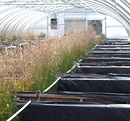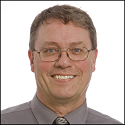Vol. 19, No. 3 - September 2018
View the Archives

From the Director _______________________________________
It has been a busy summer, capped off with a great Users' Conference last week. Thank you to everyone who helped to organize or participate in the many sessions and discussions. We are preparing to restart SPEAR and resume user operations on most beam lines in late October. As mentioned previously, we are also working to bring up several new beam lines including BL12-1 (micro-beam macromolecular crystallography), BL15-2 (spectroscopy XES-RIXS-XRS - time resolved), BL16-1/2 (metrology) and later BL17-2 (energy sciences materials scattering). I look forward to seeing users on our experimental floor again!
Science Highlight ________________________________________
Gold Nanoparticle Biodissolution by a Freshwater Macrophyte and Its Associated Microbiome – Contact: Greg Lowry, Carnegie Mellon University Nanotechnology, which focuses on materials that measure between 1 and 100 nanometers in at least one dimension, is being applied to diverse areas of research including medicine, electronics, and biology. Yet it is unclear how these engineered nanomaterials might interact with and affect environments and ecosystems. Read more… SSRL-Related News _______________________________________2018 SSRL/LCLS Users' Meeting About 470 researchers gathered for our Annual SSRL/LCLS Users' Meeting Sept. 25-28 to attend talks and poster sessions, participate in workshops, and engage in discussions involving the lab’s x-ray light sources. Harriet Kung led off the Thursday, September 27 plenary session with an update from the DOE Office of Basic Energy Sciences. LCLS Director Mike Dunne and SSRL Director Kelly Gaffney followed with facility updates. Eric K. Lin (NIST), Junko Yano (LBNL), David Reis (Stanford PULSE and SIMES Institutes), and Peter Weber (Brown University) gave the invited plenary talks. Another highlight of the meeting was the presentation of the LCLS Young Investigator Award, William E. and Diane M. Spicer Young Investigator Award, Melvin P. Klein Scientific Development Award and Farrel W. Lytle Award. The 2018 meeting organizers were Arianna Gleason of Stanford, vice chair of the LCLS Users’ Executive Committee; Graham George of the University of Saskatchewan in Canada, vice chair of the SSRL Users’ Executive Committee; and SLAC scientists Sergio Carbajo and Kevin Stone. Click here to read more and view the slideshow.How SLAC's 'Electronics Artists' Enable Cutting-Edge Science Excerpt from August 23, 2018 SLAC Today article by Manuel Gnida A team of electrical designers are developing specialized microchips for a broad range of scientific applications, including x-ray science and particle physics, made possible in part through x-ray applications at SSRL. Read more... Winning Photos from the 2018 SLAC Physics Photowalk The SLAC Photowalk took a group of photographers, both amateur and professional, behind the scenes to photograph SLAC's world-class science facilities, including LCLS and SSRL. The three winning photos competed in the Global Physics Photowalk against photos taken at other big scientific labs around the world. Read more... Honors and Awards _______________________________________Graham George Receives Lytle Award for Contributions to X-ray Absorption Spectroscopy Excerpt from September 11, 2018 SLAC Today article by Aiko Takeuchi-Demirci
Joe Wong Outstanding Poster Awards Congratulations to the recipients of the 2018 Joe Wong Outstanding Poster Award Competition at the SSRL/LCLS Annual Users’ Meeting on September 27, 2018!
These awards are made possible by support from longtime SSRL user, Joe Wong, Ph.D., D.Sc., Fellow of the American Physical Society, and are given to the most exciting, novel, and compelling science as presented during the poster session at the SSRL/LCLS Annual Users’ Meeting. Thank you very much to all of the judges! Upcoming Events and Courses _______________________________
Announcements __________________________________________Changes at SLACafé SLACafé is now open from 8 a.m. to 3 p.m., Monday through Friday (except holidays). Although the daily hot breakfast menu is no longer available, you can still grab pre-made breakfast options from 8 a.m. every morning. The SLACafé also reports that they will be offering lower prices for hot food and the salad bar at 69 cents per ounce, plus hot soup for $3.95, effective October 1. The new weekly Chef’s Special, value combos, and a new selection of cold beverages and desserts are still being offered daily. Food menu options and service times: 8 a.m. to 3 p.m. - Grab N Go items, including pre-packaged breakfast sandwiches Check the weekly menu on the SLACafé website. Visitors staying at the Stanford Guest House are offered complimentary breakfast, and Starbucks also provides breakfast options to both staff and guests. Breakfast catering will still be available upon request, with the full menu on offer. Vending Machine Update You may have noticed that the Pepsi vending machines were removed. The new contract has been awarded to Coca-Cola, and we expect new vending machines to be installed and stocked with products soon. New Electric Vehicle Charging Stations SLAC is enhancing the network of electric vehicle (EV) charging stations in various parking lots, including:
Usage fees have increased from 7 cents per kilowatt-hour to 10 cents per kilowatt-hour to partially reimburse network maintenance. User Research Administration _______________________________Run Schedule Update The beam time schedule for the October 2018-January 2019 run cycle is posted. To date, we have been able to accommodate 505 out of 805 requests for beam time (~63%). Many factors are considered in scheduling SSRL beam time. Priority is given to highly rated proposals, while also considering the amount of beam time that has previously been allocated as well as the proposal team's demonstrated productivity (publications). Other factors are availability of both equipment and beam line staff. Experiments with similar equipment configuration set ups are scheduled together whenever feasible for maximum efficiency and to minimize downtime. A rating of ~1.45 is generally the initial cutoff for beam time on most oversubscribed SSRL beam lines. Additional requests are kept in the queue and may be accommodated to fill cancelled beam time. If members of the same research team have several proposals, they will not necessarily be granted beam time for each proposals or request in each scheduling period. Many SSRL beam lines are oversubscribed with highly rated proposals; consequently, requests for the most oversubscribed beam lines will likely be limited to one or two experiments per research group per run cycle or run year, depending on the specific beam line availability. Call for User Publications and Reminder to Acknowledge SSRL and Funding Agencies Publications are an important metric of productivity, and we need your help to keep up-to-date publication listings for all peer-reviewed journal papers, book chapters, conference proceedings and theses based on work conducted here – this allows us to demonstrate the scientific achievements and productivity of SSRL and our user community. After data have been collected, analyzed and prepared for publication, inform us and acknowledge us and our funding agencies in each publication using the formats posted on the our website. It is extremely important that you contact us before exciting results are about to be published so that we can work with you, your institution and the SLAC Office of Communication to track publications related to the user facility, to develop science highlights and to communicate the latest research findings to a broader audience including funding agencies. User science highlights, as well as other news and announcements, are featured on our website and in our electronic newsletter. SSRL Beam Time Request Deadline
SSRL Proposal Deadline
See SSRL Proposal & Scheduling Guidelines and submit proposals and beam time requests through the User Portal. _____________________________________________________________________ The Stanford Synchrotron Radiation Lightsource (SSRL) is a third-generation light source producing extremely bright x-rays for basic and applied research. SSRL attracts and supports scientists from around the world who use its state-of-the-art capabilities to make discoveries that benefit society. SSRL, a U.S. DOE Office of Science national user facility, is a Directorate of SLAC National Accelerator Laboratory, operated by Stanford University for the U.S. Department of Energy Office of Science. The SSRL Structural Molecular Biology Program is supported by the DOE Office of Biological and Environmental Research, and by the National Institutes of Health, National Institute of General Medical Sciences. For more information about SSRL science, operations and schedules, visit http://www-ssrl.slac.stanford.edu. To unsubscribe from SSRL Headlines, just send an e-mail to listserv@slac.stanford.edu with "signoff ssrl-headlines" in the body. To subscribe, send an e-mail to listserv@slac.stanford.edu with "subscribe ssrl-headlines" in the body. Questions? Comments? Contact Tomoko Nakai or Lisa Dunn
| |||||||||||



